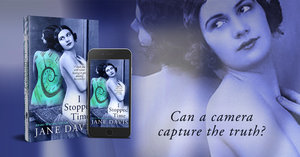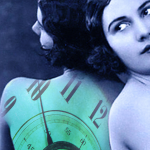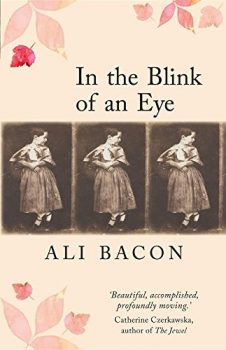Imagine, if you will, discovering of a cache of photographs; the instinctive knowledge that what you are holding in your hands is rare and precious. You won’t be the first to experience this feeling, but that hardly matters. It will feel as though you are.
Anthony Penrose grew up thinking that he had one famous parent, but in the aftermath of his mother’s death he made a remarkable discovery. A treasure trove of 60,000 negatives, prints and manuscripts, his mother Lee Miller’s life’s work. And they revealed a side of her he’d known nothing about.
More recently, photographer Eric Swayne (who died in 2007), left behind a cardboard box marked ‘do not throw out’. In it his sons discovered some of the most unforgettable black and white images taken in the Sixties: Keith Richards, Mick Jagger, Jane Birkin.
Collector John Maloof bought a box of Vivian Maier’s photographs in 2007. He shared them on Flickr while piecing her life together from the images, in which Maier shows us the extraordinary in the everyday.
I Stopped Time: the story of a century
In my novel, I Stopped Time, a reclusive ex-politician, Sir James Hastings, takes a delivery. He hasn’t placed an order for anything, but the boxes keep on coming. They fill his hall. They contain his mother’s legacy: the photographs she took over the course of almost a century. At first, Sir James wants nothing to do with them. This was the woman who abandoned him as a child. But gradually he comes to see the world through his mother’s eyes. And he realises that she was not the villain of his childhood – far from it.
One of my greatest influences when writing the book was Lartique’s Album of a Century. Opening the album for the first time, the hairs on the back of my neck stood on end. I realised that I was looking at a family photograph album – albeit one belonging to an incredibly talented amateur. Nothing is hidden. The collection charts his privileged upbringing, the inventions of motor cars, the first few experiments with flight, his marriage, his children, the loss of a child, his affairs… That was what my book needed to do. It was an incredibly proud moment when one reviewer wrote, ‘This book voiced everything I’ve held inside of me as a photographer.’
In the Blink of an Eye by Ali Bacon (Linen Press)
My first choice (and my favourite of the selection) takes us back to the early days of photography. Not only did In the Blink of an Eye teach me something – about the link between Robert Adamson and William Henry Fox Talbot. But Rock House, situated on the slopes of Edinburgh’s Carlton Hill (and one of the novel’s key settings) was familiar to me. I had holidayed there in the summer of 2016.
In 1843, David Octavius Hill was commissioned to paint the portraits of 400 ministers of the new Free Church. The task was daunting. How could one artist capture the likenesses of so many men? How many years might it take? And who to paint first? Only when Hill met Robert Adamson, a pioneering photographer, did the project begin to look feasible.
Ali Bacon doesn’t only give us Hill and Adamson, but the women they captured in their photographs. Ali Bacon cleverly turns the camera on the men so that we see them through those women’ eyes. Jessie Mann who assisted Hill and Adamson in making calotypes, now acknowledged as the first Scottish female photographer; the sculptress Amelia Paton; and Jane Adamson, sister of Robert. Other women, too, whose names have been forgotten by history are brought to life.
Because Hill was a respected artist who saw the enormous potential of photography, opinion about photography changed. It, too, could be an artform.
Read my interview with the author here.
The Bohemians by Jasmin Darznik
Documentary photographer Dorothea Lange (1895 – 1965) captured some of the most memorable images of the Great Depression. Of these, Migrant Mother may be the best-known example.
In The Bohemians, Darznik takes us back to 1918 and Dorothea Lange’s arrival in San Francisco, a city devastated by an earthquake only twelve years earlier. (Like my character Lucy Forrester in My Counterfeit Self, Dorothea contracted polio as a child, and walked with a limp.) Almost immediately, every dime she has is stolen. But what seems to be a disaster provides a spring-board into a new life. A chance meeting with ‘Caroline Lee’, an elegant and vivacious Chinese American leads quickly to friendship. This friendship is the seam that holds the novel together. Through Caroline, Dorothea is introduced to an artists’ colony, the bohemian heart of the city called Monkey Block.
‘They’d all come from somewhere else, and they all had a story to tell. That was another thing about San Francisco: Every time you met someone, it was like stepping into a story just as they were making it up. And now I was one of them. Or starting to be.’
Dorothea Lange isn’t the only photographer we meet in The Bohemians. The ‘someones’ include Consuelo Kanga, Imogen Cunningham and Ansel Adams.
In this heady new environment, and with Caroline at her side as her creative partner, Dorothea, succeeds in creating a flourishing photographic studio – something that is almost unheard of for women at the time. But a meeting with charismatic and troubled artist Maynard Dixon proves to be a distraction from her work. Then a devastating betrayal pushes the women’s friendship to breaking point.
The Age of Light by Whitney Scharer
I have always had a fascination with Lee Miller, but was too much in awe of her to attempt a fictionalised version of her life. And yet this is exactly what debut novelist Whitney Scharer’s did, triggering a bidding war, won by Little, Brown and Company with an advance rumoured to be in seven-figures. They saw The Age of Light as a feminist story for our times. The truth is that Lee Miller was always several steps ahead of the crowd. For me it was a ‘must-read’.
‘Paris, 1929. Lee Miller has abandoned her modelling career at New York’s Vogue, and move to Paris to pursue her dream. She wants to be behind the camera, not in front of it. When she catches the eye of artist Man Ray she convinces him to hire her as his assistant. Man is an egotistical, charismatic force and they soon embark upon a passionate affair.’
In 2011, Scharer went to see an exhibition called Partners in Surrealism: Man Ray and Lee Miller. She knew about Man Ray but this was the first time she’d heard of Lee Miller. Her question was why not? Scharer says she was fascinated by what type of woman brings an egotistical artist like Man Ray to his knees.
It is the love affair and the beginning of Lee Miller’s artistic journey that is Scharer’s focus. She traces an arc from the pair’s early attraction as they worked side by side in his studio to the slow corrosion of their relationship. You can watch Book Report Network’s interview with Whitney Scharer here.
Sweet Caress by William Boyd
I loved the idea of William Boyd’s novel. Who doesn’t look at a ‘found photo’ and wonder about the person pictured? Boyd chose seventy-five and built a life around them.
The novel’s narrator is Amory Clay, born 1908, who, at the age of seventy, is reflecting on her life. Amory’s photographic career took her from London where she photographed the smart set, to Berlin where she captured its nightlife. She then shot fashion for a New York magazine. But after she was caught up in the blackshirt riots in London’s East End she became a photo-journalist, reporting on the second world war in Normandy, and, much later, on the Vietnam war. Now she embarks on a personal mission to track down her daughter, Blythe.
Said Boyd of the task, “When you’re constructing a life you have to use a lot of artifice to make it seem artless, a lot of organisation to make it seem random – because life is random,” said Boyd.
For me, Boyd cast the net too wide. Each segment of the novel seemed underdeveloped. I didn’t feel the atmosphere of Berlin nightlife. I didn’t experience the chaos and the terror of the blackshirt riots. But more than that, I didn’t feel Amory – or Boyd’s – love of photography. Like it or not, there are three aspects to photography – the technical, the emotional and being in the right place at the right time. You might call it chance, or opportunity. Boyd gave us hints of the technical, he gave us the opportunities: what he didn’t give us was emotion.
Reading the book forces a reader to confront their own prejudices. Sweet Caress certainly gave me a number of uncomfortable moments. Seeing the photographs in context, I realised that I was making far more judgements about its characters than I would have done had the author simply described them. The women in the pictures – Amory included – weren’t beautiful, and yet we were supposed to believe that, after a chance meeting, one man crossed continents to track her down. And unfortunately Boyd didn’t reveal enough about Amory’s personality to convince me that she was intriguing. In fact, to the very end, Amory Clay remained elusive.
And there was another problem. The photographs themselves. They were far too weak to make Amory Clay’s remarkable successes seem credible.
Instead, Boyd’s creative coup came in the most unexpected of places – the acknowledgements at the back of the book. After a lifelong love affair with photography I was familiar with most of photographers he mentions. But scattered among the names of real women are two of Boyd’s creations, Renata Alabama and Mary Poundstone.
Still Life with Bread Crumbs by Anna Quindlen
Still Life with Bread Crumbs does a brilliant job of depicting the randomness of artistic success. Rebecca Winter is a 60-year-old divorcee with a flagging career. Twenty years earlier, she was a struggling photographer who’d always planned her shoots meticulously. Then one fateful morning she decided on a whim to photograph the debris from the previous evening’s dinner party. One of what became known as her ‘Kitchen Counter’ series, the Still Life with Bread Crumbs of the book’s title, won a major award and captured the public’s imagination, making her an unlikely champion of everyday women. Now, offers of work have dried up. In a desperate attempt to balance the books, Rebecca sublets her New York apartment, exchanging it for a cabin in the middle of nowhere.
In the woods behind the cabin, Rebecca does what she has always done. She begins to photograph what she stumbles across. Mysterious white crosses with accompanying pieces of memorabilia: a small trophy, the plaster cast of a handprint. But thinking of the objects in terms of composition, framing and light, she fails to ask herself. Is there a story behind these miniature shrines?
Jubilee by Shelley Harris
A single photograph can be used brilliantly – powerfully – as the premise of an entire novel. Try the prologue of Shelley Harris’ Jubilee. You can read it here. The story that unravels, is of course, about those before and after moments. But it’s that description of photography – its purpose – that stuck with me long after I turned the last page.
More books about photographers or photography
Self-Portrait with Boy by Rachel Lyon
Wyld Dreamers Pamela Holmes
The Color of Ice by Barbara Linn Probst
Never Anyone But You by Rupert Thomson
The Cottingley Cuckoo by A. J. Elwood
Portrait of Peril is Laura by Joh Rowland
One Last Shot by Kip Wilson
The Woman in the Photograph by Cathryn Grant
Waiting for Robert Capa by Susana Fortes
Multiple Exposure by Ellen Crosby
The Book of Lost Light by Ron Nyren
The Girl with the Leica by Helena Janeczek
The Photographer’s Wife by Nick Alexander
Before the Rains by Dinah Jefferies
Close Up by Amanda Quick
Honeysuckle Season by Mary Ellen Taylor
Take me Apart by Aara Sliger
The Lightkeepers by Abby Geni
Sold on a Monday by Kristina McMorris
The Photographer’s Saga by Patra Durst Benning
The People in the Photo by Helene Gestern
The Beautiful American by Jeanne Mackin
The Mercury Visions of Louise Daguerre
The Paris Orphan by Natasha Lester
Feast Your Eyes by Myla Goldberg
The Friday Night Club by Sofia Lundberg
Queen of the Owls By Barbara Linn Probst
The Measure of Silence by Elizabeth Langston
The Photographer by E S Blake
Georgia By Dawn Tripp
The Bridges of Madison County
Hold Still by Sally Mann
The Only True Genius in the Family by Jennie Nash Moments
Captured by Robert J. Seidman
Caught in the Light by Robert Goddard
Trick of Light by David Hunt
The Shimmering State by Meredith Westgate
The Magician’s Tale by David Hunt
The Museum of Extraordinary things by Alice Hoffman
Star Island by Carl Hiaasen
The Shadow Catcher by Marianne Wiggins
Bonfire Night by Anna Bliss
Picture Palace by Paul Theroux
The Glass House by Jody Cooksley
Eight Girls Taking Pictures by Whitney Otto
Click: One Novel, Ten Authors
The Big Picture by Douglas Kennedy
The Dark Room by Rachel Seiffert
Sixty Lights by Gail Jones
Shooting the Moon by Frances O’Roark Dowell
Zero to the Bone by Robert Eversz
The Amber Photograph by Penelope J Stokes
Sources of Light by Margaret McMullan
Boy Parts by Eliza Clark
Her Last Flight by Beatriz Williams
The Road Home by Michael Thomas Ford
The Weight of Water by Anita Shreve
The Woman in the Photograph by Stephanie Butland
Of Love and Shadows by Isabel Allende
Leading Lines by Chantel Guertin
The Photograph by Penelope Lively
The Smoke Jumper by Nicholas Evans
Depth of Field by Chantel Guertin
The Camera Never Lies by Elizabeth Goddard
Lost Children Archive by Valeria Luiselli
Little Fires Everywhere by Celeste Ng
Lying Low by Diane Johnson
Trick of Light by David Hunt
The Rule of Thirds by Chantel Guertin
Love and Summer by William Trevor
To The Bright Edge of the World
Unseen Consolation by Michael Redhill
The Luminist by David Rocklin
Mary Coin by Marisa Silver
The Cage by Audrey Schulman
Afterimage by Helen Humphreys
The Illuminations by Andrew O’Hagan
The Measure of Silence by Elizabeth Langston
Songdogs by Collum McCan
The Incorrigibles by Meredith Jaeger
Exhibit by R O Kwon
To have future posts delivered directly to your in-box, visit the sidebar on the right and subscribe to my blog, or to find out about new releases, competitions and freebies, subscribe to my newsletter and I will send you a free copy of my novel, I Stopped Time, as a thank you.
While I have your attention, can I please draw your attention to my updated Privacy Policy. (You may have noticed, they’re all the rage.) I hope this will reassure you that I take your privacy seriously.
Remember, if you enjoyed this post please share it.
If you have subscribed to my blog but no longer wish to receive these posts, simply reply with the subject-line ‘UNSUBSCRIBE’ and I will delete you from my list.







